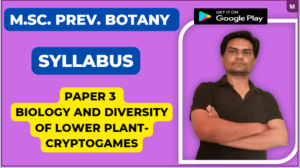![]()
Paper 2 : Cytology, Genetics and Cytogenetics
Unit 1
Cytology
Chromatin organization : Chromosome struture and packing of DNA, molecular organization of centromere and telomere, nucleolus and ribosomal RNA genes, ceuchromatin and heterochromatin, karyotype analysis, banding patterns karyotypes evolution, specialized types of chromosomes, polytene, lampbrush,B-chromosomes and sex chromosome, molecular basis of chromosome pairing.
Structural and numerical alteration in chromosome, Origin meiosis and breeding behaviour of duplication, deficiency, inversion and translocation heterozygotes. Origin, occurrence, production and meiosis of haploids, aneuploids and euploids, origin and production of autopolyploids, chromosome and chromatid segregation , allopolyploids, types, genome constitution, and analysis, evolution of major crop plant induction and characterization of trisomics and monosomics.
Unit 2
Genetics
Genetics of prokaryotes and eukaryotic organelles: Mapping the bacteriophage genome, phage phenotypes genetic recombination in phage, genetic transformation, conjugation and transduction in bacteria, genetics of mitochondria and chloroplast, cytoplasmic male sterility.
Gene structure and expression : Genetic fine structure cis and trans test, fine structure analysis of eukaryotes introns and their significance, RNA splicing regulation of gene expression in prokaryots and eukaryotes. Panoply of operon, catabolite repression , attenuation and antitermination.
Genetic recombination and genetic mapping : Recombination independent assortment and crossing over, molecular mechanism recombination, role of RecA and RecBCD enzyme, site specific recombination, chromosome mapping, linkage groups, genetic markers. Construction of molecular maps, correlation of genetic and physical maps somatic cell genetics – an alternative approach to gene mapping.
Unit 3
CYTOGENETICS
Mutations : Spontaneous and induced mutation, physical and chemical mutagens, molecular basis of gene mutation, transposable elements in prokaryotes and eukaryotes, mutations induced by transposons, site directed mutagenesis, DNA damage and repair mechanisms, inherited diseases and defects in DNA repair. Initiation of cancer at cellular level, protooncogenes and oncogenes.
Sex deternmination, sex linked inheritance, sex limited characters and sex reversal, multiple allele’s and blood groups in man
Cytogenetics of aneuploids and structural heterozygotes : Effect of aneuploidy on phenotype in plants, transmission of monosomics and trisomics and their use in chromosome mapping in diploid and polyploid species, breeding behaviour and genetics of structural heterozygotes, complex translocation heterozygotes. Translocation tester sets, Robersonian translocation B-A translocation.
Unit 4
Molecular cytogenetics: Nuclear DNA content C-Value paradox, cot curve and its significance, restriction mapping- concept and techniques, multigene families and their evolution, in situ hybridization – concept and techniques, physical mapping of genes of chromosomes, computer assisted chromosome analysis, chromosome microdissection and microcloning. Flow cytometry and confocal microscopy in karyotype analysis.
Alien gene transfer through chromosome manipulations:
Transfer of whole genome, examples from wheat, Arachis and Brassica transfer of individual chromosomes and chromosome segments methods for detecting alien chromatin, production, characterization and utility of alien addition and substitution lines, genetic basis of inbreeding and heterosis, exploitation of hybrid vigour.



